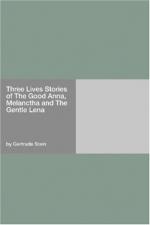|
This section contains 351 words (approx. 1 page at 400 words per page) |

|
Melanctha Summary & Study Guide Description
Melanctha Summary & Study Guide includes comprehensive information and analysis to help you understand the book. This study guide contains the following sections:
This detailed literature summary also contains Bibliography on Melanctha by Gertrude Stein.
Gertrude Stein's "Melanctha" has been a landmark of literary modernism since its first printing. The author broke radically new ground with both her subject matter and style. She focused on emotional process almost to the exclusion of action and other conventional plot structures, and she chose to people her story with black characters at a time when other white writers wouldn't do so and when few black writers had the opportunity to publish. Furthermore, Stein's central character—Melanctha—was sexually liberated and assertive at a time when Victorian values still dominated women's lives.
First published in 1909 as one of the three novellas that comprise Stein's Three Lives, "Melanctha" is an experimental story that chronicles the life of a highly intelligent, emotionally complex mulatto woman. The basis of Stein's story arises from Melanctha's emotional conflicts, for which the author never provides a direct cause: Melanctha wanders through life, always in search of something—some knowledge, some experience—she can never wholly acquire. At a time when women were expected to choose conventional and safe paths—marriage, children, middle-class life, if possible—Melanctha is a kind of rebel because her undefinable questing suggests a woman's desire for more, though more what, the author never says. The central relationship of the story, Melanctha's love affair with the young doctor, Jefferson Campbell, also wanders aimlessly, despite Jeff's solidly middle-class aspirations. Telling their story, the narrator highlights the emotional process of their efforts to know and communicate with one another, rather than the progress of their relationship toward some socially-sanctioned goal.
In order to capture her subject matter—the reality of emotional life that may go on unseen beneath the surface—Stein began to experiment with new ways to use words and sentences, developing an essentially new aesthetic, or way of portraying the world through art. Consequently, the reader tackling "Melanctha" is confronted with dense language: thick repetition, grammatically incorrect sentences, a limited and often vague diction—a language designed not so much to explain the characters' emotions as to evoke the immediacy of emotion.
Read more from the Study Guide
|
This section contains 351 words (approx. 1 page at 400 words per page) |

|



